When calling the saveAll method of my JpaRepository with a long List<Entity> from the service layer, trace logging of Hibernate shows single SQL statements being issued per entity.
Can I force it to do a bulk insert (i.e. multi-row) without needing to manually fiddle with EntityManger, transactions etc. or even raw SQL statement strings?
With multi-row insert I mean not just transitioning from:
start transaction
INSERT INTO table VALUES (1, 2)
end transaction
start transaction
INSERT INTO table VALUES (3, 4)
end transaction
start transaction
INSERT INTO table VALUES (5, 6)
end transaction
to:
start transaction
INSERT INTO table VALUES (1, 2)
INSERT INTO table VALUES (3, 4)
INSERT INTO table VALUES (5, 6)
end transaction
but instead to:
start transaction
INSERT INTO table VALUES (1, 2), (3, 4), (5, 6)
end transaction
In PROD I'm using CockroachDB, and the difference in performance is significant.
Below is a minimal example that reproduces the problem (H2 for simplicity).
./src/main/kotlin/ThingService.kt:
package things
import org.springframework.boot.autoconfigure.SpringBootApplication
import org.springframework.boot.runApplication
import org.springframework.web.bind.annotation.RestController
import org.springframework.web.bind.annotation.GetMapping
import org.springframework.data.jpa.repository.JpaRepository
import javax.persistence.Entity
import javax.persistence.Id
import javax.persistence.GeneratedValue
interface ThingRepository : JpaRepository<Thing, Long> {
}
@RestController
class ThingController(private val repository: ThingRepository) {
@GetMapping("/test_trigger")
fun trigger() {
val things: MutableList<Thing> = mutableListOf()
for (i in 3000..3013) {
things.add(Thing(i))
}
repository.saveAll(things)
}
}
@Entity
data class Thing (
var value: Int,
@Id
@GeneratedValue
var id: Long = -1
)
@SpringBootApplication
class Application {
}
fun main(args: Array<String>) {
runApplication<Application>(*args)
}
./src/main/resources/application.properties:
jdbc.driverClassName = org.h2.Driver
jdbc.url = jdbc:h2:mem:db
jdbc.username = sa
jdbc.password = sa
hibernate.dialect=org.hibernate.dialect.H2Dialect
hibernate.hbm2ddl.auto=create
spring.jpa.generate-ddl = true
spring.jpa.show-sql = true
spring.jpa.properties.hibernate.jdbc.batch_size = 10
spring.jpa.properties.hibernate.order_inserts = true
spring.jpa.properties.hibernate.order_updates = true
spring.jpa.properties.hibernate.jdbc.batch_versioned_data = true
./build.gradle.kts:
import org.jetbrains.kotlin.gradle.tasks.KotlinCompile
plugins {
val kotlinVersion = "1.2.30"
id("org.springframework.boot") version "2.0.2.RELEASE"
id("org.jetbrains.kotlin.jvm") version kotlinVersion
id("org.jetbrains.kotlin.plugin.spring") version kotlinVersion
id("org.jetbrains.kotlin.plugin.jpa") version kotlinVersion
id("io.spring.dependency-management") version "1.0.5.RELEASE"
}
version = "1.0.0-SNAPSHOT"
tasks.withType<KotlinCompile> {
kotlinOptions {
jvmTarget = "1.8"
freeCompilerArgs = listOf("-Xjsr305=strict")
}
}
repositories {
mavenCentral()
}
dependencies {
compile("org.springframework.boot:spring-boot-starter-web")
compile("org.springframework.boot:spring-boot-starter-data-jpa")
compile("org.jetbrains.kotlin:kotlin-stdlib-jdk8")
compile("org.jetbrains.kotlin:kotlin-reflect")
compile("org.hibernate:hibernate-core")
compile("com.h2database:h2")
}
Run:
./gradlew bootRun
Trigger DB INSERTs:
curl http://localhost:8080/test_trigger
Log output:
Hibernate: select thing0_.id as id1_0_0_, thing0_.value as value2_0_0_ from thing thing0_ where thing0_.id=?
Hibernate: call next value for hibernate_sequence
Hibernate: select thing0_.id as id1_0_0_, thing0_.value as value2_0_0_ from thing thing0_ where thing0_.id=?
Hibernate: call next value for hibernate_sequence
Hibernate: select thing0_.id as id1_0_0_, thing0_.value as value2_0_0_ from thing thing0_ where thing0_.id=?
Hibernate: call next value for hibernate_sequence
Hibernate: select thing0_.id as id1_0_0_, thing0_.value as value2_0_0_ from thing thing0_ where thing0_.id=?
Hibernate: call next value for hibernate_sequence
Hibernate: select thing0_.id as id1_0_0_, thing0_.value as value2_0_0_ from thing thing0_ where thing0_.id=?
Hibernate: call next value for hibernate_sequence
Hibernate: select thing0_.id as id1_0_0_, thing0_.value as value2_0_0_ from thing thing0_ where thing0_.id=?
Hibernate: call next value for hibernate_sequence
Hibernate: select thing0_.id as id1_0_0_, thing0_.value as value2_0_0_ from thing thing0_ where thing0_.id=?
Hibernate: call next value for hibernate_sequence
Hibernate: select thing0_.id as id1_0_0_, thing0_.value as value2_0_0_ from thing thing0_ where thing0_.id=?
Hibernate: call next value for hibernate_sequence
Hibernate: select thing0_.id as id1_0_0_, thing0_.value as value2_0_0_ from thing thing0_ where thing0_.id=?
Hibernate: call next value for hibernate_sequence
Hibernate: select thing0_.id as id1_0_0_, thing0_.value as value2_0_0_ from thing thing0_ where thing0_.id=?
Hibernate: call next value for hibernate_sequence
Hibernate: select thing0_.id as id1_0_0_, thing0_.value as value2_0_0_ from thing thing0_ where thing0_.id=?
Hibernate: call next value for hibernate_sequence
Hibernate: select thing0_.id as id1_0_0_, thing0_.value as value2_0_0_ from thing thing0_ where thing0_.id=?
Hibernate: call next value for hibernate_sequence
Hibernate: select thing0_.id as id1_0_0_, thing0_.value as value2_0_0_ from thing thing0_ where thing0_.id=?
Hibernate: call next value for hibernate_sequence
Hibernate: select thing0_.id as id1_0_0_, thing0_.value as value2_0_0_ from thing thing0_ where thing0_.id=?
Hibernate: call next value for hibernate_sequence
Hibernate: insert into thing (value, id) values (?, ?)
Hibernate: insert into thing (value, id) values (?, ?)
Hibernate: insert into thing (value, id) values (?, ?)
Hibernate: insert into thing (value, id) values (?, ?)
Hibernate: insert into thing (value, id) values (?, ?)
Hibernate: insert into thing (value, id) values (?, ?)
Hibernate: insert into thing (value, id) values (?, ?)
Hibernate: insert into thing (value, id) values (?, ?)
Hibernate: insert into thing (value, id) values (?, ?)
Hibernate: insert into thing (value, id) values (?, ?)
Hibernate: insert into thing (value, id) values (?, ?)
Hibernate: insert into thing (value, id) values (?, ?)
Hibernate: insert into thing (value, id) values (?, ?)
Hibernate: insert into thing (value, id) values (?, ?)

